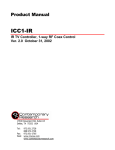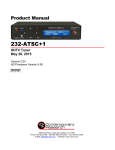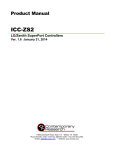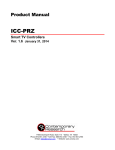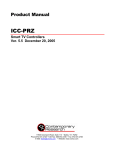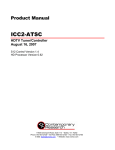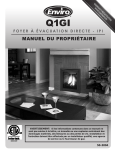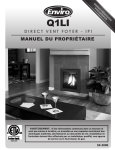Download Contemporary Research ICC2-IRC Product manual
Transcript
Product Manual ICC-HE / ICW-HE Head-End Network Controller Ver. 2.3 November 15, 2002 17630 Davenport Rd, Suite113 Dallas, TX 75252 USA Tel: 972.931.2728 888.972.2728 Fax: 972.931-2765 Web: www.crwww.com www.contemporaryresearch.com Table of Contents Overview.....................................................................................................................................................................................................................3 Specifications..............................................................................................................................................................................................................4 Physical ..........................................................................................................................................................................................................................4 Front Panel .....................................................................................................................................................................................................................4 Control Connections.........................................................................................................................................................................................................5 iCW-Net Connections (ICC-HE and ICW-HE) ......................................................................................................................................................................5 iCC-Net Connections (ICC-HE Only)...................................................................................................................................................................................6 Power Connections ..........................................................................................................................................................................................................6 Includes .........................................................................................................................................................................................................................6 Installation .................................................................................................................................................................................................................7 RF Coax and iCC-Net Operation (ICC-HE Only)...................................................................................................................................................................7 AC Power and Net LED operation......................................................................................................................................................................................7 iCW-Net Connection (ICC-HE and ICW-HE)........................................................................................................................................................................8 Remote Control Connection ..............................................................................................................................................................................................8 I/O Port Connection.........................................................................................................................................................................................................8 RS-232 Terminal Commands ......................................................................................................................................................................................9 RS-232 Control Protocol ...........................................................................................................................................................................................10 Overview ...................................................................................................................................................................................................................... 10 Command String Structure ............................................................................................................................................................................................. 10 Command format .......................................................................................................................................................................................................... 10 RS-232 HE Commands ..............................................................................................................................................................................................11 RS-232 Device Commands........................................................................................................................................................................................12 RS-232 Response......................................................................................................................................................................................................18 Response String Structure .............................................................................................................................................................................................. 18 RS-232 HE Response ................................................................................................................................................................................................19 RS-232 Device Response ..........................................................................................................................................................................................20 iC-Net Zones .............................................................................................................................................................................................................22 System Map ..............................................................................................................................................................................................................23 Typical RF and ICC-Net Signal Flow .........................................................................................................................................................................24 RF Channel Frequencies ...........................................................................................................................................................................................25 iCW-Net Wiring .........................................................................................................................................................................................................26 Safety Instructions ...................................................................................................................................................................................................27 Limited Warranty and Disclaimer .............................................................................................................................................................................28 Contemporary Research Corporation 2 ICC-HE/ICW-HE Manual Overview Contemporary Research (CR) offers two solutions for intelligent television control and distributed media management, the ICC-HE and ICW-HE Head-End Network Controllers. Both units are capable of networking up to 4,000 iC-Net TV Controllers, Display Controllers and Tuners into a unified, interactive system. The iC-Net network can be distributed over Category 3 or 5 wiring (iCW-Net) or over broadband RF coax (iCC-Net), communicating over the same CATV cable that carries the system’s TV channels. ICW-series controllers deliver 2-way control and feedback over the iCW-Net wired network, while ICC2-series and ICC1-series controllers provide 2-way and 1-way control through the iCC-Net coax network. The ICW-HE provides 2-way iCW-Net networking, distributing iC-Net commands and responses over Category 5 or 3 wiring. Three iCW-Net ports are included, each capable of connecting thousands of ICW-Net format controllers over wiring runs of up to 3,300 feet (1 Km). In addition, iCW-Net data can be sent to remote locations over fiber and video conferencing codecs. The ICC-HE features the same iCW-Net capabilities as well as distributing iCC-Net data over the CATV cable. Employing clear-channel RF frequencies to transmit and receive data, the iCC-Net network is compatible with most CATV systems without conflict with existing channels. The bi-directional network operates over a standard low-split cable system, simplifying installation and support. • • • • • Networks with up to 4,000 TVs through wired iCW-Net and broadband CATV iCC-Net networks o iCC-Net operates through same CATV coax as TV channels, requires no additional wiring o iCW-Net distributes data over Category 5 or 3 wiring, fiber optic cable, or codecs Sends commands to individual devices, zones, or all units from a single RS-232 port Interacts with CR ABC Media Retrieval Systems, iC Commander software, or custom control systems Includes local control buttons and I/O ports that can trigger events in PC software or control systems Provides LED feedback for network, control, and operation status Contemporary Research Corporation 3 ICC-HE/ICW-HE Manual Specifications Physical Size: Weight: Enclosure: Mounting: Front Panel RF Out Adjust: RS-232 TX LED: RS-232 TX LED: RS-232 DIP Switch: 19" [483mm] wide x 1.75" [38mm] height (1RU) x 9" [229mm] deep 3 lbs [1.36kg] All aluminum with durable black powder coat paint Shelf or 19” equipment rack (mounting brackets included) Trims iCC-Net channel output, shipped set to +55 dBmV (max) Yellow LED, lights when receiving RS-232 data on Remote Control RS-232 port Yellow LED, lights when receiving RS-232 data on Remote Control RS-232 port Sets RS-232 baud rate (9600 - 38.4K), 8 data bits, no parity, 1 stop bit Selects high/low sensitivity for RF In signal DIP 1 2 3 4 5 6 7 8 Net LED: COM LED: Error LED: Reset/Default: Emergency: Off RF In High Baud Baud Baud On RF In Low* Baud 38,400 19,200* 9,600 4,800 2,400 1,200 6 ON OFF ON OFF ON OFF 7 ON ON OFF OFF ON ON 8 ON ON ON ON OFF OFF *Default setting Green LED for iC-Net bus, flashes once per second if network is operating, device numbers expected agree The LED will flash twice per second if the number of present and expected devices do not match Yellow LED blinks when a valid command is received or system response sent through the Remote Control RS-232 port Red LED indicates a problem within the unit White button sends press and release RS-232 response to PC software or control system Red button sends press and release RS-232 response to PC software or control system Contemporary Research Corporation 4 ICC-HE/ICW-HE Manual Control Connections Control RS-232: DB9 female, RS-232 data link to control system or PC RS-232 Control Port iC-Net RS-232: I/O 1 & 2: I/O Applications: 5 GND GND 5 2 RXD TXD 3 3 TXD RXD 2 9-pin D-sub female DB9 female, RS-232 data link to send iCW-Net over fiber or codec 4-pin captive screw terminal for Input/Outputs 1 and 2 2 switch closures or inputs, max 50 mA, 24 VDC, switch to GND 1 – +12 VDC 2 – Output 2 3 – Output 1 4 – GND DC power – close pins 1 & 3 to provide DC on/off Dry closure 2 – close pins 3 & 4 for dry contact to external power relay, AMX PC1 or similar Sense closure (3 & 4) on Input 1 – trigger control system to power off for all rooms iCW-Net Connections (ICC-HE and ICW-HE) iCW-Net 2, 3 RJ-45 female 8 pin Telco jack, supports 3300 ft [1 km] of wire RS-422/485 type data requiring at least 2 twisted wire pairs with shield or fifth conductor iCW-Net 1: 6-pin captive-screw terminal for system wiring or use with RS-422/485-format fiber or codecs iC-Net Expand RJ-11 female 6-pin Telco jack Recommended Wire: CAT5/CAT3 compatible unshielded, max 3,300 feet [1 Km] from Head End Contemporary Research Corporation 5 ICC-HE/ICW-HE Manual iCC-Net Connections (ICC-HE Only) RF In: ‘F’, female, 75 ohm impedance, RF and iCC-Net from CATV system Data Receive: Carried over the same RF coax connection as TV channels Return signal from system controllers Sub-band, 5.6MHz, narrow-band signal below standard sub-band channels -15 to +35 dBmV signal level (0 to +15 dBmV nominal) RF Out: F’, female, 75 ohm impedance, RF to CATV distribution to TVs, tuners, and controllers Data Transmit: Mid-band VHF, 74.7 MHz, narrow-band signal between channels 4 and 5 ± 80 KHz max carrier deviation +55 dBmV maximum (default) Power Connections Power In: 2.1mm coaxial jack (inside center conductor positive), 11 to 18 VDC, 12 VDC typical, 300 mA maximum (may be unregulated) UL/CSA listed wall power supply (included for domestic 110 VAC/60 Hz shipments only) Includes 10 dB RF attenuator 12 VDC Power Supply Contemporary Research Corporation 6 ICC-HE/ICW-HE Manual Installation RF Coax and iCC-Net Operation (ICC-HE Only) 1. Connect an RF coax feed from RF Out to the system’s RF combiner, mixing the iCC-Net Out signal with the other CATV channels. The iCC-Net Out channel operates at 74.7 MHz, in between cable channels 4 and 5. 2. In most applications, you will connect the included 10 dB attenuator in between, trimming the He’s standard 55 dB output to 45 dB. 3. Using an RF signal level meter, use the front panel RF Out adjustment counterclockwise to match the RF Out signal to the other CATV sources. Limit RF Out adjustment to -10 dB, using attenuators to achieve a lower signal strength. 4. Add a Sub-CATV Diplexer after the CATV amplifier. 5. Connect the Sub-Channel output of the Diplexer to the HE RF In connection. AC Power and Net LED operation 1. Insert DC power supply plug into the Power In jack. 2. Plug power adaptor into AC wall outlet, the front-panel LEDs should turn on momentarily. 3. If iC-Net communication is functioning, the Net LED will flash once per second, or twice per second (the double-flash, indicating a difference between present and expected device, would be typical in the initial phase of the installation.) Contemporary Research Corporation 7 ICC-HE/ICW-HE Manual iCW-Net Connection (ICC-HE and ICW-HE) 1. Plug the iCW-Net RJ-45 plug into the iCW-Net jack 2 or 3. Each iCW-Net port can support cable runs of up to 3,300 feet of wire. See iCW-Net Wiring for wiring structure and alternatives. 2. The iCW-Net port 1 uses a removable screw terminal (included) for wiring to Cat3/5 or RS-422/485 connections to fiber optics or codecs. Call Contemorary Research to coordinate use of fiber optic equipment. Each make and model often requires different wiring and electronic solutions for proper operation. 3. The iC-Net RS-232 port is used to extend iCW-Net control to remote locations through fiber, codecs or other RS-232 format equipment. The equipment at the remote end will need an RS-422/485 adapter to provide iCW-Net networking. See page 4 for RS-232 cable wiring diagram. Remote Control Connection 1. Attach appropriate RS-232 cable to Remote Control RS-232 port. See page 4 for RS-232 cable wiring diagram. 2. Set desired baud rate on front-panel DIP switch. Default setting is 19.2K baud – see page 4 for DIP switch setting information. I/O Port Connection 1. A simple contact closure can be wired to I/O 1 or 2, a press or release can trigger events in the PC or control system software. 2. In other applications, the I/O ports can act as closure outputs, activating an external power relay, 2x1 video switcher or other device. 3. You’ll have to choose application – the ports act as either an output or input, not both. See Control Connections on page 4 for wiring and rating information. Contemporary Research Corporation 8 ICC-HE/ICW-HE Manual RS-232 Terminal Commands Employ standard Windows Terminal program, set to baud rate match DIP switch setting on front of HE. Command Description Commands shown in ASCII and end with carriage return (Decimal 13, Hex $0D, or Enter key. Response displays * character to signify end of characters, or times out if no characters are received after 2 seconds. Echo Enable Tip: Just hit Enter to repeat any Terminal command. EN Enables character echo so you can see typed characters on screen. Echo Disable EF Version VE Displays HE software version. Reset Z! Show Devices SD Displays list of 2-way devices stored in HE memory. List can be created by iC Commander software, ABC-MRC software, or Scan and Build command below. Disables terminal character display (default). Performs system reset. Show Missing Example Response: Devs Present: 257-261 263 265-271* SM Displays list of missing 2-way devices (compared to HE memory list). Show Present Example Response: Devs Missing: 262 -263 264* SP Displays number of present devices and number of devices expected. Scan and Show Scan and Build Show Log Clear Log Example Response: Num Devs Present : 1 Num Devs Expected : 53 SZ Scans iC-Net and displays list of all 2-way devices found (does not change HE memory). Z^ Scans iC-Net and saves list of all 2-way devices found into HE memory. L Returns four hex bytes, separated by commas. If any of the bytes change as you repeat the command, there is likely an error in return communication from iC-Net devices. DL Clears the L hex bytes to zero. Contemporary Research Corporation 9 ICC-HE/ICW-HE Manual RS-232 Control Protocol Overview RS-232 control for up to 4000 iC-Net devices is provided through an iC-series Head-End Network Controller. The ICC-HE HeadEnd manages iC-Net communication over RF Coax to ICC-series devices as well as ICW-series devices over twisted-pair Cat3/5 wiring. The ICW-HE Head-End operates on the Cat5 network only. Each device is assigned a unique device number from 1 to 4000 to which control commands are addressed. The devices are organized into 16 zones of 255 devices. All the devices in each zone will respond to a single “virtual device number” — one device number that represents all devices in each zone. There is also a global device number, 4095, that will command all devices in the system. This feature dramatically speeds up system operation and programming, because one command can affect an entire group of devices—or all. To take advantages of this feature, review the section iC-Net Zones in this manual. In ABC Media Retrieval Systems, we reserve the first group of devices, 1-255, for components operating on a connected control system. Zones 1-16 are used for CR TV Controllers, Video Display Controllers and Tuners. As it’s unlikely any system will use all 4000 devices, this may be a good device standard for your system as well. The Remote RS-232 port on the Head-End Network Controller can communicate from 1200 to 38.4K baud. The factory default setting is 19.2K baud, 8 data bits, No parity, and 1 stop bit. Command String Structure Characters in command strings are expressed in a combination of hex and ASCII characters. • • • • • • • Single-byte hex numbers are preceded by the ‘$’ symbol ASCII characters or strings are enclosed in single quotes Numbers not marked as hex or ASCII are a single decimal byte Parameters shown in < > brackets are single byte A series of multiple commands or parameters are set apart by [ ] brackets Commas separate the bytes, but are not part of the protocol Double quotes enclose the command string, but are not part of the protocol Contemporary Research Corporation 10 Command format “$A5,<dh>,<dl>,<ncb>,<cmd1>,<parameter> [<cmdN>]" $A5 <dh> <dl> <ncb> <cmd1> <parameter> [<cmdN>] Starts the command The zone or high order byte of the device The unit or low order byte of the device (0 for global zone) The number of command bytes to follow The first command byte Command parameters (not used by all commands) Multiple commands can be concatenated, with byte count added to <ncb> ICC-HE/ICW-HE Manual RS-232 HE Commands The following commands apply to the HE only. Commands addressed to controllers are included with the Product Manual for the specific device. Command Closures Y_ Description “$A5,0,0,3, ‘Y’ <I/0 Port>’ ” (7 bytes) Turns the two internal closures on and off. Closure 1 is typically used to control the optional buzzer, Closure 2 typically used to control an external camera power relay. Device Status SP “$A5,0,0,3, ‘Y10’” turns Closure “$A5,0,0,3, ‘Y11’” turns Closure “$A5,0,0,3, ‘Y20’” turns Closure “$A5,0,0,3, ‘Y21’” turns Closure "$A5,0,0,2,'SP'" (6 bytes) 1 1 2 2 off on off on Queries the Head-End for the number of devices present on the network and the number of devices expected. Contemporary Research Corporation 11 ICC-HE/ICW-HE Manual RS-232 Controller Commands The following commands summarize RS-232 commands to iC-Net controllers. There is a high degree of compatibility between Contemporary Research devices, most commands execute a similar action or response in nearly all units. Refer to each unit’s Product Manual for specific programming information. Command Description ICC/W IRC ICC2 VDC ICW VDC ICC ICW ICC/W ZS2 ICC1 IR Power Off PO “$A5,<dh>,<dl>,2,’P0’ ” (6 bytes) – checks status for true power control X 3 3 X X X Power On P1 “$A5,<dh>,<dl>,2,’P1’ ” (6 bytes) – checks status for true power control X 3 3 X X X Power Toggle PT “$A5,<dh>,<dl>,2,’PT’ ” (6 bytes) – checks status for true power control X 3 3 X X X Operating Parameters TM “$A5,<dh>,<dl>,3,’TM’,<setting>” (7 bytes) X X X 1 1 2 Volume VL X X X X X X X X X Power-up Volume Sets up key functions in the unit bit 7 – 3 = 0 bit 2 – Channel up/down operation, 0=Tune Ring, 1=Send IR Keypad response bit 1 – Numeric channel labels, 0=num labels off, 1=num labels on) bit 0 – Alpha channel labels, 0=alpha labels off, 1=alpha labels on “$A5,<dh>,<dl>,3,’VL’,<vol level>” (7 bytes) Sets volume level 0 = Mute 1 – 63 = Minimum level (1) to maximum volume (63) S5 "$A5,<dh>,<dl>,3,'S5',<volume>" (7 bytes) Sets volume level when IRC powers up 0 = restore to previous level 1 – 63 = Set from minimum (1) to maximum level (63) Mono/Stereo S0 “$A5,<dh>,<dl>,3,’S0’, <mode>” (7 bytes) 0=mono, 1=stereo Bass Gain S7 “$A5,<dh>,<dl>,3,’S7’, <mode>” (7 bytes) Sets bass gain Treble Gain S9 “$A5,<dh>,<dl>,3,’S9’, <mode>” (7 bytes) Sets treble gain Notes 1 1-way models do not send a response (bit 2) 2 ICC1 does not provide channel labels or response 3 Sends discrete power on and power off commands Contemporary Research Corporation 12 X X X ICC-HE/ICW-HE Manual Command Description ICC/W IRC ICC2 VDC ICW VDC ICC ICW ICC/W ZS2 ICC1 IR T Channel Up TU “$A5,<dh>,<dl>,2,’TU’ ” (6 bytes) – Tunes to next channel up in Tune Ring X X X X X 1 T Channel Dwn TD “$A5,<dh>,<dl>,2,’TD’ ” (6 bytes) – Tunes to next channel down in Tune Ring X X X X X 2 Force T Chan X X X X X 2 X X X X X 2 Channel T? “$A5,<dh>,<dl>,2,’T?’ ” (6 bytes) – Request response for current channel Query Q Channel Up QU “$A5,<dh>,<dl>,2,’QU’ ” (6 bytes) – Tunes to next channel up in Tune Ring X X X 1 1 1 X X X X X X Q Channel Dwn QD “$A5,<dh>,<dl>,2,’QD’ ” (6 bytes) – Tunes to next channel down in Tune Ring X X X X X X Force Q Chan QC “$A5,<dh>,<dl>,3,’QC’, <channel>” (7 bytes) – Tunes to a specific channel X X X X X X Select Q Chan Same special-function channels as in the T Channel Select section above QT “$A5,<dh>,<dl>,2,’TT’ ” (6 bytes) – Tunes channel if included in Tune Ring X X X X X X Ts & Qs T-series channel commands select a channel and display the channel label on the TV, while Q-series commands don’t show the on-screen text. TC “$A5,<dh>,<dl>,3,’TC’, <channel>” (7 bytes) – Tunes to a specific channel 124 = 125 = 126 = 127 = 0= 255 = Select T Chan Notes TT 1 2 RGB 2 input on TV RGB input on TV Select external A/V input (IRC/VDC also selects TV video input) Select S-Video Input Blank video output to TV Unblank TV video (restore to previous channel) Tip: Not all inputs are available on every TV make and model. “$A5,<dh>,<dl>,2,’TT’ ” (6 bytes) – Tunes channel if included in Tune Ring 1-way models do not provide response Does not provide channel label display, obeys both T and Q commands Contemporary Research Corporation 13 ICC-HE/ICW-HE Manual Command Description ICC/W IRC ICC2 VDC ICW VDC ICC ICW ICC/W ZS2 ICC1 IR 1 Tuner Mode SO "$A5,<dh>,<dl>,3,'S0',<tune mode>" (7 bytes) X X X X Tune Ring Sets tuner mode to CATV or Broadcast/Antenna 0 = CATV 1 = Broadcast/Antenna 2 = HRC TR “$A5,<dh>,<dl>,<ncb>,’TR’, [<chan 1>, <chan N>]” (variable bytes) X X X 1 1 X X X X X X X X X X This command stores a Tune Ring, a series of preset channels accessed by channel up/down commands. Channel Labels Ex1: “$A5,<dh>,<dl>,6,’TR’, 5,4,8,11” sets ring to channels 5, 4, 8 and 11 Tip: The ring follows the stored order, channels do not have to be in ascending order x Ex2: “$A5,<dh>,<dl>,2,’TR’ ” clears the Tune Ring, locks unit to current channel Tip: In the above mode, the IR Keypad channel up/down response to the HeadEnd, so the system will know the user is trying to change channels. In response, the system could change channels on a media sources, like a VCR or satellite. See K response note in RS-232 Responses. Ex3: “$A5,<dh>,<dl>,8,’TR’, $82,5,$87,11” sets channels 2-5 and 7-11. You can specify a range using MSB bit for the first channel; the next byte is the last. TN “$A5,<dh>,<dl>,<ncb>,‘TN’,<channel>,<label>” (variable bytes) Stores an ASCII string as the channel label. The text will appear briefly when the channel is selected, if the feature has been activated by TM command. Ex1: “$A5,<dh>,<dl>,3,‘TN’, ‘7’, ‘PBS’ ” unit displays PBS when 7 is selected Ex2: “$A5,<dh>,<dl>,3,‘TN’, ‘7’ ” Clears alpha label for channel 7 Ex3: “$A5,<dh>,<dl>,3,‘TN’,0,0” Clears all alpha labels Display Label TC “$A5,<dh>,<dl>,2,’TC’ ” (6 bytes) – Display current channel label for about 15 sec Notes 1 1-way units do not send the K keypad responses in Ex2. Contemporary Research Corporation 14 ICC-HE/ICW-HE Manual Command Closures Description Y- “$A5,<dh>,<dl>,3, ‘Y’ <I/0 Port>’ ” (7 bytes) ICC/W IRC ICC2 VDC ICW VDC ICC ICW ICC/W ZS2 ICC1 IR X X X X X X X X X 2 X X X 1 1 Turns the two internal closures on and off. Closure 1 is typically used to control the optional buzzer, Closure 2 typically used to control an external camera power relay. Control Lock “$A5,<dh>,<dl>,3, ‘Y10’” turns Closure 1 off “$A5,<dh>,<dl>,3, ‘Y11’” turns Closure 1 on “$A5,<dh>,<dl>,3, ‘Y20’” turns Closure 2 off “$A5,<dh>,<dl>,3, ‘Y21’” turns Closure 2 on LM “$A5,<dh>,<dl>,3,'LM',<control>” (7 bytes) Locks out front panel and IR remote control functions. Bit 7 Selects IR remote control operation (0=enabled, 1=disabled) Bit 6 Selects volume control operation (0=enabled, 1=disabled) Bit 5 - 1 Always 0 Bit 0 Selects front panel button operation (0=enabled, 1=disabled) Device Status SP "$A5,0,0,2,'SP'" (6 bytes) Notes 1 2 Queries the Head-End for the number of devices present on the network and the number of devices expected. 1-way units do not respond to command Locks out IR remote control only Contemporary Research Corporation 15 ICC-HE/ICW-HE Manual Command Write Text Description DM “$A5,<dh>,<dl>,<ncb>,‘DM’, <start line>,<text color>,<background color>, <background>,<size and shadow>,<timeout>,<message bytes>” (variable bytes) ICC/W IRC ICC2 VDC ICW VDC ICC ICW ICC/W ZS2 1 1 1 X X ICC1 IR Clears current text, displays text message over video (default) or blank background. The built-in character generator can accept up to 40 characters of text (including carriage returns), 28 characters per line. Use a hex $0D or decimal 13 in the text as a carriage return, which will advance CG to the next line, first space on the right. Start Line - 1-11 Text Color - 1-7= White Text Background Color – 0-7=Transparent (no background) Full screen background – 0=normal insert over video, 1=blank screen (blue) Size and Shadow – 0-3=small text with drop shadow Time-Out – 0=15-second display, 1=persistent Persistent text stays on screen until the next DM, or new Menu or channel. Ex1: “$A5,<dh>,<dl>,10,‘DM’, 2,7,0,0,1,0,’TEST’ ” displays the word TEST on the second line, white text, inserted over video, small size with drop shadow, and timing out after 15 seconds. Ex2: “$A5,<dh>,<dl>,2,‘DM’ ” clears on-screen display, also clears persistent text Notes 1 The IRC and VDC use white text and clear backgrounds when it receives a Text or Background Color parameter between 1 and 7, and accepts values 0-3 for text size and shadow. This allows compatibility with Smart TVs mixed in the same system that can display other colors and fonts. Unit will respond to all formatting commands, using white text on transparent background Contemporary Research Corporation 16 ICC-HE/ICW-HE Manual Command Description ICC2 VDC ICW VDC X X X Advanced Fast Write DN Write Here Clears display, writes specified text starting at column 1, row 1. $0D and hex $EA, $EB, $DC, and $DB can be included, operate same as matching commands below. DW “$A5,<dh>,<dl>,<ncb>,’DW’, <text> ” (variable bytes) X X X Writes specified text starting at present cursor position. Accepts same Hex as DN. “$A5,<dh>,<dl>,4,’DG’, <row>, <column>” (8 bytes) X X X X X X Row, Column DG The following commands provide advanced CG text operation “$A5,<dh>,<dl>,<ncb>,’DN’, <text> ” (variable bytes) ICC/W IRC Cursor Column Cursor Row E7 Moves the cursor to the specified row and column position. If row is 0, then row will not be changed, and if column is 0, then column will not be changed. “$A5,<dh>,<dl>,3,’E7’, <column>” (7 bytes) – sends cursor to specified column. E8 “$A5,<dh>,<dl>,3,’E8’, <row>” (7 bytes) – sends cursor to specified row. X X X Return EB “$A5,<dh>,<dl>,2,’EB’ ” (6 bytes) X X X Clear All EA Moves cursor down to the first column of the next row. “$A5,<dh>,<dl>,2,’EA’ ” (6 bytes) X X X Clear to End DC Clears display, sends cursor to column 1, row 1. “$A5,<dh>,<dl>,2,’DC’ ” (6 bytes) X X X Clear Line DB Clear on-screen display from cursor to end of screen, position stays the same. “$A5,<dh>,<dl>,2,’DB’ ” (6 bytes) X X X Clear Spaces E9 Clear on-screen display from cursor to end of line, cursor position stays the same. “$A5,<dh>,<dl>,3,’E9’, <num spaces>” (7 bytes) X X X Clears specified number of spaces, starting from cursor to the right. “$A5,<dh>,<dl>,3,’DQ’, <time>” (7 bytes) X X X Text Timeout DQ ICC ICW ICC/W ZS2 ICC1 IR Sets screen timeout to specified time in seconds (1-254). If time is 0 or 255, any text on the screen will persist indefinitely, or until cleared. Contemporary Research Corporation 17 ICC-HE/ICW-HE Manual RS-232 Response Contemporary Research 2-way iC-Net devices will send a response over the network whenever there is there is a change in status or command from an IR remote or front panel. Response String Structure Characters in response strings are expressed in a combination of hex and ASCII characters. For clarity, the following protocol examples use the following conventions: • • • • • • ASCII characters or strings are shown enclosed in single quotes Numbers shown that are not in single quotes are a single decimal byte Parameters shown in < > brackets are single byte A series of multiple commands or parameters are set apart by [ ] brackets Commas separate the bytes, but are not part of the protocol Double quotes enclose the command string, but are not part of the protocol Command format: “ ‘<’,<dh>,<dl>,<nrb>,<rb1>, <para1> [<rbN>]" ‘>’ <dh> <dl> <nrb> <rb1> <para1> [<rbN>] Starts the response The zone or high order byte of the device The unit or low order byte of the device (0 for global zone) The number of response bytes to follow The first response byte Associated parameters, if any Multiple responses may be included Contemporary Research Corporation 18 ICC-HE/ICW-HE Manual RS-232 HE Response The following responses apply to the HE only. Response Key-I/O K Description “ ‘<’,0,0,2,'K',<IR Key>" (6 bytes) Sent when the Reset or Emergency buttons are pressed, or when I/O 1 or 2 receives a closure. PC software or a control system connected to the Control RS-232 port can receive the response and activate a programmed event. Device Query SP 101 = Reset button pressed 229 = Reset button released 102 = Emergency button pressed 230 = Emergency button released 103 = I/O 1 input closed 231 = I/O 1 input opened 104 = I/O 2 input closed 232 = I/O 2 input opened " '<',0,0,4,'SP',<number devices present>,<number devices expected> (8 bytes) Sent in response to HE Device Status query. Tip: If the number of present and expected devices match, the green Net LED on the HE will blink once per second. If the two numbers do not agree, the LED blinks twice per second. Contemporary Research Corporation 19 ICC-HE/ICW-HE Manual RS-232 Device Response The following responses are common to all iC-Net 2-Way devices. Response New Channel T Description “ ‘<’,<dh>,<dl>,2,'T',<new channel>" (6 bytes) IR Function Sent in response to T? command. “ ‘<’,<dh>,<dl>,2,'F',<IR Function>" (6 bytes) R Sent when unit receives a new function command is pressed (1-8) or released (0) from the IR remote. IR Key K 0 = Release 1 = Play 2 = Stop 3 = Pause 4 = Fast Forward 5 = Rewind 8 = Record “ ‘<’,<dh>,<dl>,2,'K',<IR Key>" (6 bytes) Sent when unit receives a new key command is pressed (10-23) or released (0) from the IR remote. 0 = Release 10 - 19 = Numeric keypad entry 0 – 9 21 = Enter 22 = Channel Up 23 = Channel Down 29 = Menu 101 = Previous Channel 102 = Timer 105 = Media Menu 106 = Cursor Right 107 = Cursor Left 108 = Cursor Up 109 = Cursor Down 110 = Media Select The 0 – 9, Channel Up/Down functions are sent only if enabled in the TM command (Bit 2 = 1). The Channel Up/Down responses will be sent if the Tune Ring contains no channels – see Ex2 in the Tune Ring command section. Contemporary Research Corporation 20 ICC-HE/ICW-HE Manual Response IR Menu M Description “ ‘<’,<dh>,<dl>,5,'M',<msh>, <msl>, <mph>, <mpl>" (9 bytes) Sent when unit receives a new Menu command is pressed or released (0) from the IR remote. Menu Selection high and low bytes are in <msh> and <msl>. Menu Parameter high and low bytes are in <mph> and <mpl>. A Menu command is initiated by pressing the Menu key, followed by a numeric entry, then the Enter or Channel Up key. During the Menu process, the Channel Down key acts as a backspace or delete key. Some selections that need only a single numeric entry and will have a parameter value of zero (0). Those keys are 0, 8, 9, 18, 20, 30, 900, 911, and 912. Menu selections that will prompt the user to enter a second parameter entry are: 1 = Select Media 2 = Password 3 = Chapter Search 4 = Frame Search 11 = Channel 21 = Page Zone 22 = Page Room 25 = Go 21 = Attach Zone 32 = Attach Room Tip: The Menu entries are active even if the TV power is off. Contemporary Research Corporation 21 ICC-HE/ICW-HE Manual iC-Net Zones To simplify controlling groups of devices, iC-Net is divided into 16 zones of 255 devices. All the devices within each zone can be controlled simultaneously by sending a command to a single “virtual device number”. For example, noting the zone chart below, if we send a Power On command to device #256, any TV controller numbered between 257 and 511 will instantly turn on. If we send a Power Off command to device #4095, all devices in the system will turn off. This is an immensely powerful feature, because most systems can only address one device at time. So if you need to turn off all 50 TV in a zone, you would need to send 50 commands. In addition to the hassles of creating multiple commands, there would be a long delay between the first and last command. One command, instant response is easier. ABC Media Retrieval Systems reserve Zone 0 for devices used in the central control system, 1 -15 for iC-Net devices. This structure may be useful for your application, or you could use Zone 0 just like any other iC-Net zone. Zone 0 1 2 3 4 5 6 7 8 9 10 11 12 13 14 15 All Zones Tip: First Device 1 257 512 769 1025 1281 1537 1793 2049 2305 2561 2817 3073 3329 3585 3841 Last Device 255 511 767 1023 1279 1535 1791 2047 2303 2559 2815 3071 3327 3583 3839 4000 Virtual Device 0 256 512 768 1024 1280 1536 1792 2048 2304 2560 2816 3072 3328 3584 3840 4095 You've probably figured out that you never want to assign a virtual device number to an actual device in the system. If you assigned #1536 to a device, all the TV controllers in Zone 6 would respond every time you sent a command to that one device. Contemporary Research Corporation 22 ICC-HE/ICW-HE Manual System Map One of the key tasks for iC-Net integrators is to create a logical System Map, assigning device numbers to TV controllers so they fall into logical zones. The device mapping could be sorted by type or location; whichever suits the application. iC-Net Zone 1 2 3 4 Zone W 1st Floor W 2nd Floor E 1st Floor E 2nd Floor Room Device W151 W152 W153 W154 257 258 259 260 W251 W252 W253 W254 E151 E152 E153 E154 E251 E252 E253 E254 Contemporary Research Corporation 256 512 513 514 515 516 iC-Net Zone Zone 5 Coffee Areas 6 1024 Device G100 G150 G151 1281 1282 1283 Day Care TV 1 TV 2 7 Hallways W1 W2 E1 E2 768 769 770 771 772 Room 8 Office Admin A/V Center All Zones All 1280 1536 1537 1538 1792 1793 1794 1795 1796 2048 2049 2050 4095 1025 1024 1025 1026 23 ICC-HE/ICW-HE Manual Typical RF and ICC-Net Signal Flow This diagram shows the structure of a typical Contemporary Research media retrieval system. One of the key aspects for iCC-Net communication is to provide a forward and return (sub-channel) path for data if you’re using 2-way TV Controllers. Contemporary Research Corporation 24 ICC-HE/ICW-HE Manual RF Channel Frequencies Channel Bandwidth Channel Bandwidth Channel Bandwidth Channel Bandwidth iCC-Net 5.6 (Return) 14 216.0 - 222.0 58 426.0 - 432.0 93 636.0 - 642.0 T7 5.75 - 11.75 15 222.0 - 228.0 59 432.0 - 438.0 94 642.0 - 648.0 T8 11.75 - 17.75 16 228.0 - 234.0 60 438.0 - 444.0 95 648.0 - 654.0 T9 17.75 - 23.75 17 234.0 - 240.0 61 444.0 - 450.0 96 654.0 - 660.0 T 10 23.75 - 29.75 18 240.0 - 246.0 62 450.0 - 456.0 97 660.0 - 666.0 T 11 29.75 - 35.75 19 246.0 - 252.0 63 456.0 - 462.0 98 666.0 - 672.0 T 12 35.75 - 41.75 20 252.0 - 258.0 64 462.0 - 468.0 99 672.0 - 678.0 T 13 41.75 - 47.75 21 258.0 - 264.0 65 468.0 - 474.0 100 678.0 - 684.0 2 54.0 - 60.0 22 264.0 - 270.0 66 474.0 - 480.0 101 684.0 - 690.0 3 60.0 - 66.0 23 270.0 - 276.0 67 480.0 - 486.0 102 690.0 - 696.0 4 66.0 - 72.0 24 276.0 - 282.0 68 486.0 - 492.0 103 696.0 - 702.0 iCC-Net 74.7 (Send) 25 282.0 - 288.0 69 492.0 - 498.0 104 702.0 - 708.0 5 76.0 - 82.0 26 288.0 - 294.0 70 498.0 - 504.0 105 708.0 - 714.0 6 82.0 - 88.0 36 294.0 - 300.0 71 504.0 - 510.0 106 714.0 - 720.0 95 90.0 - 96.0 37 300.0 - 306.0 72 510.0 - 516.0 107 720.0 - 726.0 96 96.0 - 102.0 38 306.0 - 312.0 73 516.0 - 522.0 108 726.0 - 732.0 97 102.0 - 108.0 39 312.0 - 318.0 74 522.0 - 528.0 109 732.0 - 738.0 98 108.0 - 114.0 40 318.0 - 324.0 75 528.0 - 534.0 110 738.0 - 744.0 99 114.0 - 120.0 41 324.0 - 330.0 76 534.0 - 540.0 111 744.0 - 750.0 14 120.0 - 126.0 42 330.0 - 336.0 77 540.0 - 546.0 112 750.0 - 756.0 15 126.0 - 132.0 43 336.0 - 342.0 78 546.0 - 552.0 113 756.0 - 762.0 16 132.0 - 138.0 44 342.0 - 348.0 79 552.0 - 558.0 114 762.0 - 768.0 17 138.0 - 144.0 45 348.0 - 354.0 80 558.0 - 564.0 115 768.0 - 674.0 18 144.0 - 150.0 46 354.0 - 360.0 81 564.0 - 570.0 116 774.0 - 780.0 19 150.0 - 156.0 47 360.0 - 366.0 82 570.0 - 576.0 117 780.0 - 786.0 20 156.0 - 162.0 48 366.0 - 372.0 83 576.0 - 582.0 118 786.0 - 792.0 21 162.0 - 168.0 49 372.0 - 378.0 84 582.0 - 588.0 119 792.0 - 798.0 22 168.0 - 174.0 50 378.0 - 384.0 85 588.0 - 594.0 120 798.0 - 804.0 7 174.0 - 180.0 51 384.0 - 390.0 86 594.0 - 600.0 121 804.0 - 810.0 8 180.0 - 186.0 52 390.0 - 396.0 87 600.0 - 606.0 122 780.0 - 786.0 9 186.0 - 192.0 53 396.0 - 402.0 88 606.0 - 612.0 123 786.0 - 792.0 10 192.0 - 198.0 54 402.0 - 408.0 89 612.0 - 618.0 124 792.0 - 798.0 11 198.0 - 204.0 55 408.0 - 414.0 90 618.0 - 624.0 12 204.0 - 210.0 56 414.0 - 420.0 91 624.0 - 630.0 13 210.0 - 216.0 57 420.0 - 426.0 92 630.0 - 636.0 HRC Frequencies = Standard frequencies minus 1.25 MHz, except for Channel 5, Video = 78.0 MHz, Channel 6, Video = 84.0 MHz IRC Frequencies = Same as standard frequencies, except for Channel 5, Video = 79.25 MHz, Channel 6, Video = 85.25 MHz Contemporary Research Corporation 25 ICC-HE/ICW-HE Manual iCW-Net Wiring Use Category 5 or Category 3 wire, 4 pair, unshielded, 24 AWG. The iCC-HE and iCW-HE Head-End Network Controllers include three iCW-Net ports for twisted-pair wired networking. Control wiring can be home-run to ports or run in a star format, using punch-down blocks or RJ-45 “harmonicas” to distribute signals to multiple iCW-Net devices. Open wiring runs do not need termination. Head-End iCW-Net #1 Screw Terminals PWR+ RXD+ RXDTXD+ TXDGND 6 5 4 3 2 1 Punch-down Blocks RJ-45 Harmonicas Wall Plates iCW Series iCW-Net RJ-45 BRN/WHT WHT/BRN GRN/WHT WHT/BLU BLU/WHT WHT/GRN ORG/WHT WHT/ORG 8 7 6 5 4 3 2 1 8 7 6 5 4 3 2 1 8 7 6 5 4 3 2 1 TXD+ TXDGND RXD+ RXDNC NC NC BRN/WHT WHT/BRN GRN/WHT WHT/BLU BLU/WHT WHT/GRN ORG/WHT WHT/ORG 8 7 6 5 4 3 2 1 8 7 6 5 4 3 2 1 8 7 6 5 4 3 2 1 TXD+ TXDGND RXD+ RXDNC NC NC iCW-Net #2, #3 RJ-45 RXD+ RXDGND TXD+ TXDNC NC NC 8 7 6 5 4 3 2 1 Contemporary Research Corporation 26 ICC-HE/ICW-HE Manual Safety Instructions Read before operating equipment. 1. Cleaning - Unplug this product from the wall outlet before cleaning. Do not use liquid cleaners or aerosol cleaners. Use a damp cloth for cleaning. 2. Power Sources - Use supplied or equivalent UL/CSA approved low voltage DC plug-in transformer. 3. Outdoor Antenna Grounding - If you connect an outside antenna or cable system to the product, be sure the antenna or cable system is grounded so as to provide some protection against voltage surges and built-up static charges. Section 810 of the National Electrical Code, ANSI/NFPA No. 70, provides information with respect to proper grounding of the mast and supporting structure, grounding of the lead-in wire to an antenna discharge unit, size of grounding conductors, location of antenna discharge unit, connection to grounding electrodes, and requirements for the grounding electrode. 4. Lightning - Avoid installation or reconfiguration of wiring during lightning activity. 5. Power Lines - Do not locate an outside antenna system near overhead power lines or other electric light or power circuits or where it can fall into such power lines or circuits. When installing an outside antenna system, refrain from touching such power lines or circuits, as contact with them might be fatal. 6. Overloading - Do not overload wall outlets and extension cords as this can result in a risk of fire or electric shock. 7. Object and Liquid Entry - Never push objects of any kind into this product through openings as they may touch dangerous voltage points or short out parts, resulting in a fire or electric shock. Never spill liquid of any kind on the product. 8. Servicing - Do not attempt to service this product yourself as opening or removing covers may expose you to dangerous voltage or other hazards. Refer all servicing to qualified service personnel. 9. Damage Requiring Service - Unplug this product from the wall outlet and refer servicing to qualified service personnel under the following conditions: • When the power supply cord or plug is damaged. • If liquid spills or objects fall into the product. • If the product is exposed to rain or water. • If the product does not operate normally by following the operating instructions. Adjust only those controls that are covered by the operating instructions. An improper adjustment of other controls may result in damage and will often require extensive work by a qualified technician to restore the product to its normal operation. • If the video product is dropped or the cabinet is damaged. • When the video product exhibits a distinct change in performance, this indicates a need for service. Note to CATV system installer: This reminder is provided to call CATV system installer's attention to Article 820-40 of the National Electrical Code (Section 54 of Canadian Electrical Code, Part I), that provides guidelines for proper grounding and, in particular, specifies that the cable ground shall be connected to the grounding system of the building as close to the point of cable entry as possible. Contemporary Research Corporation 27 ICC-HE/ICW-HE Manual Limited Warranty and Disclaimer Contemporary Research Corporation (CR) warrants this product to be free from defects in material and workmanship under normal use for a period of two years from the date of purchase from CR. Should such a defect occur CR will repair or replace, at their option, the defective product at no cost for parts or labor. This warranty extends to product purchased directly from CR or an Authorized CR Dealer. Consumers should inquire from selling dealer as to the nature and extent of the dealer's warranty, if any. All warranty claims must be shipped pre-paid to the factory. Call or fax to obtain a Return Material Authorization (RMA) number. CR is not liable for any damages caused by any of its products or for the failure of any products to perform, including any lost profits, lost savings, incidental damages, or consequential damages. CR is not responsible for any claim made by a third party or made for you by a third party. This limitation of liability applies whether damages are sought, or a claim is made, under this warranty or as a tort claim (including negligence and strict product liability), a contract claim, or any other claim. This limitation of liability cannot be waived or amended by any person. This limitation of liability will be effective even if CR or an authorized representative of CR has been advised of the possibility of any such damages. Some states do not allow a limitation of how long an implied warranty lasts. Some states do not allow the limitation or exclusion of incidental or consequential damages for consumer products. In such states, the limitation or exclusion of the Limited Warranty may not apply to you. This Limited Warranty gives you specific legal rights. You may also have other rights that may vary from state to state. You are advised to consult applicable state laws for a full determination of your rights. Except as expressly set forth in this Limited Warranty, CR makes no other warranties, expressed or implied, including any implied warranties of merchantability or fitness for a particular purpose. CR expressly disclaims all warranties not stated in this Limited Warranty. Any implied warranties that may be imposed by law are limited to the terms of this Limited Warranty. Contemporary Research Corporation 28 ICC-HE/ICW-HE Manual






























